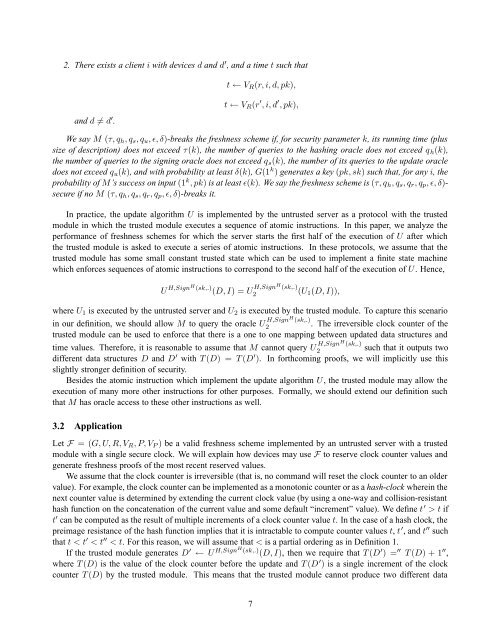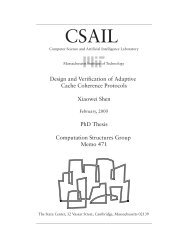Proof of Freshness - Computation Structures Group - MIT
Proof of Freshness - Computation Structures Group - MIT
Proof of Freshness - Computation Structures Group - MIT
Create successful ePaper yourself
Turn your PDF publications into a flip-book with our unique Google optimized e-Paper software.
2. There exists a client i with devices d and d ′ , and a time t such that<br />
and d = d ′ .<br />
t ← VR(r, i, d, pk),<br />
t ← VR(r ′ , i, d ′ , pk),<br />
We say M (τ, qh, qs, qu, ɛ, δ)-breaks the freshness scheme if, for security parameter k, its running time (plus<br />
size <strong>of</strong> description) does not exceed τ(k), the number <strong>of</strong> queries to the hashing oracle does not exceed qh(k),<br />
the number <strong>of</strong> queries to the signing oracle does not exceed qs(k), the number <strong>of</strong> its queries to the update oracle<br />
does not exceed qu(k), and with probability at least δ(k), G(1 k ) generates a key (pk, sk) such that, for any i, the<br />
probability <strong>of</strong> M’s success on input (1 k , pk) is at least ɛ(k). We say the freshness scheme is (τ, qh, qs, qr, qp, ɛ, δ)secure<br />
if no M (τ, qh, qs, qr, qp, ɛ, δ)-breaks it.<br />
In practice, the update algorithm U is implemented by the untrusted server as a protocol with the trusted<br />
module in which the trusted module executes a sequence <strong>of</strong> atomic instructions. In this paper, we analyze the<br />
performance <strong>of</strong> freshness schemes for which the server starts the first half <strong>of</strong> the execution <strong>of</strong> U after which<br />
the trusted module is asked to execute a series <strong>of</strong> atomic instructions. In these protocols, we assume that the<br />
trusted module has some small constant trusted state which can be used to implement a finite state machine<br />
which enforces sequences <strong>of</strong> atomic instructions to correspond to the second half <strong>of</strong> the execution <strong>of</strong> U. Hence,<br />
U H,SignH (sk,.) H,Sign<br />
(D, I) = U H (sk,.)<br />
2 (U1(D, I)),<br />
where U1 is executed by the untrusted server and U2 is executed by the trusted module. To capture this scenario<br />
in our definition, we should allow M to query the oracle U H,SignH (sk,.)<br />
2 . The irreversible clock counter <strong>of</strong> the<br />
trusted module can be used to enforce that there is a one to one mapping between updated data structures and<br />
such that it outputs two<br />
different data structures D and D ′ with T (D) = T (D ′ ). In forthcoming pro<strong>of</strong>s, we will implicitly use this<br />
slightly stronger definition <strong>of</strong> security.<br />
Besides the atomic instruction which implement the update algorithm U, the trusted module may allow the<br />
execution <strong>of</strong> many more other instructions for other purposes. Formally, we should extend our definition such<br />
that M has oracle access to these other instructions as well.<br />
time values. Therefore, it is reasonable to assume that M cannot query U H,SignH (sk,.)<br />
2<br />
3.2 Application<br />
Let F = (G, U, R, VR, P, VP ) be a valid freshness scheme implemented by an untrusted server with a trusted<br />
module with a single secure clock. We will explain how devices may use F to reserve clock counter values and<br />
generate freshness pro<strong>of</strong>s <strong>of</strong> the most recent reserved values.<br />
We assume that the clock counter is irreversible (that is, no command will reset the clock counter to an older<br />
value). For example, the clock counter can be implemented as a monotonic counter or as a hash-clock wherein the<br />
next counter value is determined by extending the current clock value (by using a one-way and collision-resistant<br />
hash function on the concatenation <strong>of</strong> the current value and some default “increment” value). We define t ′ > t if<br />
t ′ can be computed as the result <strong>of</strong> multiple increments <strong>of</strong> a clock counter value t. In the case <strong>of</strong> a hash clock, the<br />
preimage resistance <strong>of</strong> the hash function implies that it is intractable to compute counter values t, t ′ , and t ′′ such<br />
that t < t ′ < t ′′ < t. For this reason, we will assume that < is a partial ordering as in Definition 1.<br />
If the trusted module generates D ′ ← U H,SignH (sk,.) (D, I), then we require that T (D ′ ) = ′′ T (D) + 1 ′′ ,<br />
where T (D) is the value <strong>of</strong> the clock counter before the update and T (D ′ ) is a single increment <strong>of</strong> the clock<br />
counter T (D) by the trusted module. This means that the trusted module cannot produce two different data<br />
7
















